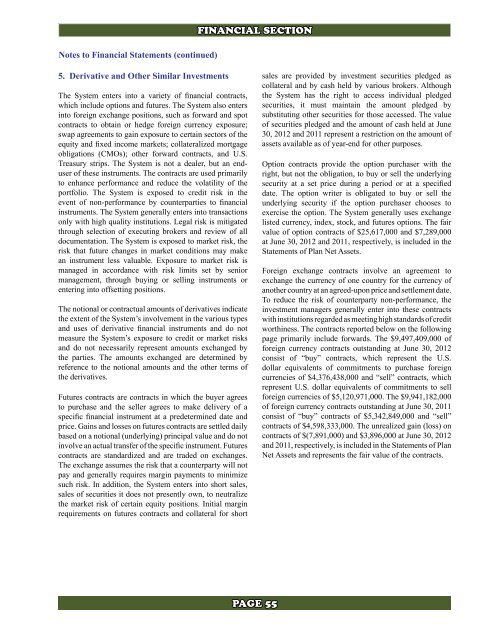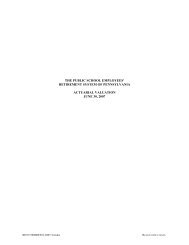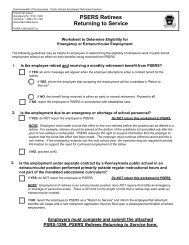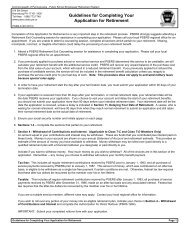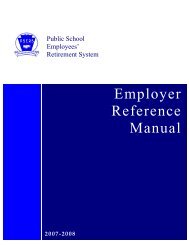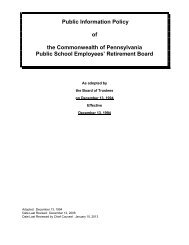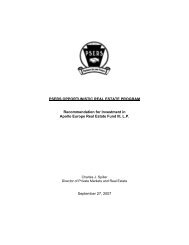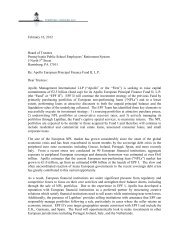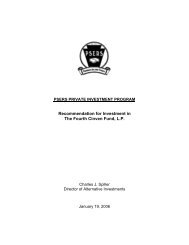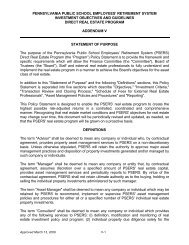a complete copy of the 2012 CAFR Report! - PSERs
a complete copy of the 2012 CAFR Report! - PSERs
a complete copy of the 2012 CAFR Report! - PSERs
Create successful ePaper yourself
Turn your PDF publications into a flip-book with our unique Google optimized e-Paper software.
Notes to Financial Statements (continued)<br />
FINANCIAL SECTION<br />
5. Derivative and O<strong>the</strong>r Similar Investments<br />
The System enters into a variety <strong>of</strong> financial contracts,<br />
which include options and futures. The System also enters<br />
into foreign exchange positions, such as forward and spot<br />
contracts to obtain or hedge foreign currency exposure;<br />
swap agreements to gain exposure to certain sectors <strong>of</strong> <strong>the</strong><br />
equity and fixed income markets; collateralized mortgage<br />
obligations (CMOs); o<strong>the</strong>r forward contracts, and U.S.<br />
Treasury strips. The System is not a dealer, but an enduser<br />
<strong>of</strong> <strong>the</strong>se instruments. The contracts are used primarily<br />
to enhance performance and reduce <strong>the</strong> volatility <strong>of</strong> <strong>the</strong><br />
portfolio. The System is exposed to credit risk in <strong>the</strong><br />
event <strong>of</strong> non-performance by counterparties to financial<br />
instruments. The System generally enters into transactions<br />
only with high quality institutions. Legal risk is mitigated<br />
through selection <strong>of</strong> executing brokers and review <strong>of</strong> all<br />
documentation. The System is exposed to market risk, <strong>the</strong><br />
risk that future changes in market conditions may make<br />
an instrument less valuable. Exposure to market risk is<br />
managed in accordance with risk limits set by senior<br />
management, through buying or selling instruments or<br />
entering into <strong>of</strong>fsetting positions.<br />
The notional or contractual amounts <strong>of</strong> derivatives indicate<br />
<strong>the</strong> extent <strong>of</strong> <strong>the</strong> System’s involvement in <strong>the</strong> various types<br />
and uses <strong>of</strong> derivative financial instruments and do not<br />
measure <strong>the</strong> System’s exposure to credit or market risks<br />
and do not necessarily represent amounts exchanged by<br />
<strong>the</strong> parties. The amounts exchanged are determined by<br />
reference to <strong>the</strong> notional amounts and <strong>the</strong> o<strong>the</strong>r terms <strong>of</strong><br />
<strong>the</strong> derivatives.<br />
Futures contracts are contracts in which <strong>the</strong> buyer agrees<br />
to purchase and <strong>the</strong> seller agrees to make delivery <strong>of</strong> a<br />
specific financial instrument at a predetermined date and<br />
price. Gains and losses on futures contracts are settled daily<br />
based on a notional (underlying) principal value and do not<br />
involve an actual transfer <strong>of</strong> <strong>the</strong> specific instrument. Futures<br />
contracts are standardized and are traded on exchanges.<br />
The exchange assumes <strong>the</strong> risk that a counterparty will not<br />
pay and generally requires margin payments to minimize<br />
such risk. In addition, <strong>the</strong> System enters into short sales,<br />
sales <strong>of</strong> securities it does not presently own, to neutralize<br />
<strong>the</strong> market risk <strong>of</strong> certain equity positions. Initial margin<br />
requirements on futures contracts and collateral for short<br />
sales are provided by investment securities pledged as<br />
collateral and by cash held by various brokers. Although<br />
<strong>the</strong> System has <strong>the</strong> right to access individual pledged<br />
securities, it must maintain <strong>the</strong> amount pledged by<br />
substituting o<strong>the</strong>r securities for those accessed. The value<br />
<strong>of</strong> securities pledged and <strong>the</strong> amount <strong>of</strong> cash held at June<br />
30, <strong>2012</strong> and 2011 represent a restriction on <strong>the</strong> amount <strong>of</strong><br />
assets available as <strong>of</strong> year-end for o<strong>the</strong>r purposes.<br />
Option contracts provide <strong>the</strong> option purchaser with <strong>the</strong><br />
right, but not <strong>the</strong> obligation, to buy or sell <strong>the</strong> underlying<br />
security at a set price during a period or at a specified<br />
date. The option writer is obligated to buy or sell <strong>the</strong><br />
underlying security if <strong>the</strong> option purchaser chooses to<br />
exercise <strong>the</strong> option. The System generally uses exchange<br />
listed currency, index, stock, and futures options. The fair<br />
value <strong>of</strong> option contracts <strong>of</strong> $25,617,000 and $7,289,000<br />
at June 30, <strong>2012</strong> and 2011, respectively, is included in <strong>the</strong><br />
Statements <strong>of</strong> Plan Net Assets.<br />
Foreign exchange contracts involve an agreement to<br />
exchange <strong>the</strong> currency <strong>of</strong> one country for <strong>the</strong> currency <strong>of</strong><br />
ano<strong>the</strong>r country at an agreed-upon price and settlement date.<br />
To reduce <strong>the</strong> risk <strong>of</strong> counterparty non-performance, <strong>the</strong><br />
investment managers generally enter into <strong>the</strong>se contracts<br />
with institutions regarded as meeting high standards <strong>of</strong> credit<br />
worthiness. The contracts reported below on <strong>the</strong> following<br />
page primarily include forwards. The $9,497,409,000 <strong>of</strong><br />
foreign currency contracts outstanding at June 30, <strong>2012</strong><br />
consist <strong>of</strong> “buy” contracts, which represent <strong>the</strong> U.S.<br />
dollar equivalents <strong>of</strong> commitments to purchase foreign<br />
currencies <strong>of</strong> $4,376,438,000 and “sell” contracts, which<br />
represent U.S. dollar equivalents <strong>of</strong> commitments to sell<br />
foreign currencies <strong>of</strong> $5,120,971,000. The $9,941,182,000<br />
<strong>of</strong> foreign currency contracts outstanding at June 30, 2011<br />
consist <strong>of</strong> “buy” contracts <strong>of</strong> $5,342,849,000 and “sell”<br />
contracts <strong>of</strong> $4,598,333,000. The unrealized gain (loss) on<br />
contracts <strong>of</strong> $(7,891,000) and $3,896,000 at June 30, <strong>2012</strong><br />
and 2011, respectively, is included in <strong>the</strong> Statements <strong>of</strong> Plan<br />
Net Assets and represents <strong>the</strong> fair value <strong>of</strong> <strong>the</strong> contracts.<br />
PAGE 55


